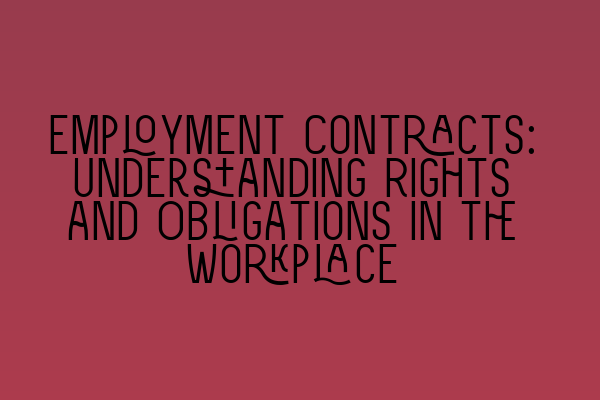Employment Contracts: Understanding Rights and Obligations in the Workplace
Welcome to our comprehensive guide to understanding employment contracts and the rights and obligations they entail. Whether you are an employer looking to draft an employment contract or an employee wanting to understand your rights, this article aims to provide you with the information you need to navigate the complex world of workplace agreements.
In today’s fast-paced business environment, having a clear and well-drafted employment contract is essential for promoting a harmonious employer-employee relationship. A properly crafted contract not only protects the rights and interests of both parties, but also provides a framework for managing potential disputes or conflicts that may arise during the course of employment.
What is an Employment Contract?
An employment contract, also known as an employment agreement, is a legally binding agreement between an employer and an employee. It outlines the terms and conditions of the employment relationship, including rights, obligations, and responsibilities of both parties.
Employment contracts can be written or verbal, although it is highly recommended to have written contracts to avoid any ambiguity or misunderstanding. Written contracts provide a clear record of the agreed terms, making it easier to resolve any disagreements that may occur in the future.
Key Elements of an Employment Contract
Employment contracts typically include the following key elements:
- Job Title and Description: The contract should clearly specify the job title and a detailed description of the employee’s role and responsibilities.
- Remuneration and Benefits: This section outlines the employee’s salary, any bonuses or incentives, as well as other benefits such as health insurance, pension contributions, and vacation entitlement.
- Working Hours: The contract should specify the employee’s regular working hours, including any flexible or shift patterns, and any additional expectations such as overtime.
- Probationary Period: If applicable, the contract may include a probationary period during which the employer can assess the employee’s suitability for the role.
- Termination Clause: This section outlines the conditions under which either party can terminate the employment contract, including notice periods and any specific grounds for termination.
- Confidentiality and Non-Compete: If necessary, the contract may contain provisions regarding confidentiality and non-compete agreements, which aim to protect the employer’s intellectual property and prevent employees from working for competitors.
These are just a few examples of the key elements that may be included in an employment contract. The specific terms and conditions will vary depending on the nature of the job and the employer’s policies.
Rights and Obligations of Employers and Employees
Employment contracts establish the rights and obligations of both employers and employees. Let’s take a closer look at each party’s responsibilities:
Employer’s Rights and Obligations:
1. Payment of Wages: Employers have a legal obligation to pay employees the agreed-upon wages on time and in full.
2. Providing a Safe and Healthy Work Environment: Employers are responsible for maintaining a safe and healthy workplace, including compliance with health and safety regulations.
3. Protecting Employee Rights: Employers must respect and protect the rights of their employees, including equal opportunity and non-discrimination.
Employee’s Rights and Obligations:
1. Performing Duties: Employees have an obligation to perform their duties to the best of their abilities and follow any reasonable instructions from their employer.
2. Confidentiality: Employees may be required to maintain confidentiality regarding sensitive company information.
3. Complying with Policies and Procedures: Employees are expected to comply with company policies and procedures, including codes of conduct, attendance policies, and dress codes.
Seeking Legal Advice
Employment contracts can be complex, and the rights and obligations they contain can have significant implications for both employers and employees. It is always advisable to seek legal advice when entering into or reviewing an employment contract.
If you need assistance with employment contracts or any other legal matters, our team of experienced solicitors at SQE Contract Law can provide expert guidance and support. Contact us today to schedule a consultation.
Conclusion
Understanding employment contracts is crucial for both employers and employees to ensure a fair and mutually beneficial working relationship. By clearly outlining the rights and obligations of all parties involved, employment contracts provide a solid foundation for a harmonious workplace.
For further information on related topics, check out these articles:
- SQE 1 Practice Exam Questions
- SQE 1 Practice Mocks FLK1 FLK2
- SQE 2 Preparation Courses
- SQE 1 Preparation Courses
- SRA SQE Exam Dates
Thank you for reading!
